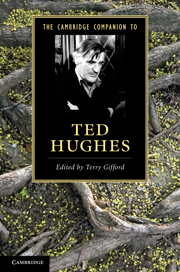Book contents
- Frontmatter
- Contents
- Acknowledgements
- Contributors
- Note on Referencing and Abbreviations
- Chronology
- Introduction
- 1 The problem of biography
- 2 The debates about Hughes
- 3 Hughes and animals
- 4 Ted Hughes and Sylvia Plath
- 5 The anthropologist’s uses of myth
- 6 Hughes’s social ecology
- 7 Hughes and feminism
- 8 Hughes and the classics
- 9 Hughes as prose writer
- 10 Hughes on Shakespeare
- 11 Class, war and the Laureateship
- 12 Hughes and his critics
- Guide to further reading
- Index
6 - Hughes’s social ecology
Published online by Cambridge University Press: 28 July 2011
- Frontmatter
- Contents
- Acknowledgements
- Contributors
- Note on Referencing and Abbreviations
- Chronology
- Introduction
- 1 The problem of biography
- 2 The debates about Hughes
- 3 Hughes and animals
- 4 Ted Hughes and Sylvia Plath
- 5 The anthropologist’s uses of myth
- 6 Hughes’s social ecology
- 7 Hughes and feminism
- 8 Hughes and the classics
- 9 Hughes as prose writer
- 10 Hughes on Shakespeare
- 11 Class, war and the Laureateship
- 12 Hughes and his critics
- Guide to further reading
- Index
Summary
In Chapter 2 Paul Bentley argues that part of the shock of Hughes’s first two books arose from his conception of ‘nature’ as what Bentley calls ‘social and even political’. In Chapter 3 Chen Hong shows how Hughes’s early animal poems were actually offered as challenges to human nature. By the time of Remains of Elmet (1979) Hughes had come to regard human culture as nature – industry, farms and people not only embedded in nature in the Calder Valley of West Yorkshire, but suffering the same processes of growth and decay: mill chimneys ‘flower’ before ‘they must fall into the only future, into earth’ (CP 457); over the generations mill workers become ‘four-cornered, stony’ as the local stone, itself ‘conscripted / Into mills’ (CP 463); scattered moorland settlements decay as ‘the fragments / Of the broken circle of the hills / Drift apart’ (CP 485). What is striking is that culture is so deeply embedded in nature that nature can also be represented as culture. Beyond the separations of simile, there is also metaphor working both ways: ‘the silence of ant-warfare on pine needles / is like the silence of clogs over cobbles’ (CP 456); the sky is a millstone ‘Grinding the skin off earth’ (CP 474). A natural silence is like the historical absence of workers’ clogs, but also, just as mill chimneys ‘flower’, weather slowly grinds the earth’s skin off. What is left of that skin are the fragments of gritstone outcrops that, in the final lines of the poem ‘Heptonstall’, can stand for both nature and the fragments of half-abandoned villages. Both outcrops and villages ‘drift apart’ in a geological timescale that changes circles of geography and history in a completely natural cyclical process.
- Type
- Chapter
- Information
- The Cambridge Companion to Ted Hughes , pp. 81 - 93Publisher: Cambridge University PressPrint publication year: 2011
- 4
- Cited by

